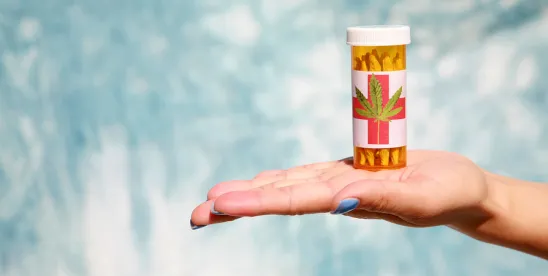Why would pharmacists, pharmacies or anyone else in the health care industry pay attention to legislation that sets the nation's agricultural and nutritional policy for the next five years? Because it includes several provisions concerning cannabis that legalize the cultivation of hemp and the sale of products derived from hemp, which contain tetrahydrocannabinol (THC).
On December 20, 2018, President Donald Trump signed the Agricultural Improvement Act of 2018, which is more commonly known as the "2018 Farm Bill." The bill represents a drastic transformation in federal hemp policy. The legalization, however, comes with several regulatory restrictions, and federal and state barriers to the growth of hemp and the sale of hemp products have not completely disappeared.
Hemp vs. Marijuana
The distinction between hemp, marijuana and cannabis is unclear to many, and the terms are often incorrectly used interchangeably. Cannabis is a family of plants. Hemp and marijuana are two different species of plants within that family. They have similar appearances, but when compared side by side, each can clearly be identified by differences in the breadth of their leaves. More importantly, hemp and marijuana differ in their concentration of THC, the chemical compound that induces psychoactive effects or, in other words, gets the user high.
The THC concentration in marijuana exceeds 15 percent, enough to create a psychoactive effect, whereas the THC levels in hemp of 0.3 percent or less are too low to create an effect. Outside of the United States, hemp has been cultivated for a variety of industrial purposes and, increasingly, to produce cannabidiol (CBD), a natural health and wellness product marketed and sold as a nutritional supplement. In the United States, however, the Controlled Substances Act classified all forms of cannabis as marijuana. Furthermore, marijuana and THC in any concentration were both listed as Schedule I controlled substances, thereby making hemp illegal. With some exceptions for clothing, industrial materials and products made from the plant's stalks or sterilized seeds, hemp could not be grown, so even legal products had to be manufactured from imported hemp.
2014 Farm Bill
With the passage of the 2014 Farm Bill, Congress took a small step toward changing hemp policy.
First, it clarified that notwithstanding the Controlled Substances Act or any other federal law, an institution of higher education or a state department of agriculture may grow or cultivate "industrial hemp" as part of an agricultural pilot program, provided that the growth and cultivation is allowed under the laws of the state in which the program is located.
Second, the 2014 Farm Bill drew a distinction between hemp and marijuana by defining industrial hemp as "the plant Cannabis sativa L. and any such part of such plant … with a delta-9 tetrahydrocannabinol concentration of not more than 0.3 percent …" Because the primary goal of the 2014 Farm Bill was to generate hemp research and protect its cultivation, the law did not expressly address the processing of hemp or the manufacture, distribution and sale of products made from hemp.
Further, the 2014 Farm Bill did not modify the Controlled Substances Act to exclude from Schedule I either hemp or products containing THC derived from hemp. This led to confusion about the legality of industrial hemp products under federal law. In fact, if it weren’t for annual appropriations bills that barred the U.S. Department of Justice and the U.S. Drug Enforcement Administration from using federal funds in contravention of the 2014 Farm Bill, the threat of federal criminal charges might have prevented manufacturers from distributing hemp-derived CBD products and pharmacies and other retailers from selling them.
2018 Farm Bill
The 2018 Farm Bill fills in the gaps left by the 2014 Farm Bill and clarifies that hemp and hemp products are legal. Passed by a wide bipartisan majority (386-47 in the House and 87-13 in the Senate), the legislation is a gargantuan 641-page document in which just a few provisions concerning hemp are buried among many others that address farm subsidies, food stamps, crop exports, conservation practices, crop insurance, rural development, animal health, specialty and organic crops, and assistance to beginning farmers and ranchers.
While the hemp provisions may be short, they are nonetheless mighty.
Section 12619 of the 2018 Farm Bill amends the Controlled Substances Act in two ways:
-
It removes hemp from the definition of marijuana in section 102(16) of the Controlled Substances Act, 21 U.S.C. § 802(16).
-
In listing THC as a Schedule I controlled substance in section 202(c) of the Controlled Substances Act, 21 U.S.C. § 812(c), it creates an exception for tetrahydrocannabinols in hemp.
Section 10113 of the 2018 Farm Bill defines hemp more broadly than the 2014 Farm Bill defined "industrial hemp" thus eliminating any question that both the plants and products derived from the plants are legal, so long as the THC concentration does not exceed 0.3 percent. In that regard, section 10113 provides that "the term 'hemp' means the plant Cannabis sativa L. and any part of that plant, including the seeds thereof and all derivatives, extracts, cannabinoids, isomers, acids, salts, and salts of isomers, whether growing or not, with a delta-9 tetrahydrocannabinol concentration of not more than 0.3 percent on a dry weight basis." Any cannabis plant or product that contains more than 0.3 percent THC will still be considered marijuana under federal law.
The newly enacted legislation does not mean that hemp will immediately become a cash crop or that farmers can grow it as freely as they do corn, soybeans, wheat or tobacco. Before hemp can be grown outside of a pilot program conducted by an institution of higher education or a state department of agriculture, the state in which it is grown must first create – and the U.S. Department of Agriculture (USDA) must approve – a plan under which the state will monitor and regulate production.
Each state regulatory plan must include a practice for maintaining information regarding the land where hemp is grown, a procedure for testing THC concentration, a procedure for disposing of plants and products produced in violation of the law, and a procedure for ensuring that the state will take appropriate actions for violations of federal hemp laws. In states that do not devise their own regulatory programs, the USDA will create a federal licensing scheme. One year after the USDA creates its plan, the provision of the 2014 Farm Bill that authorized pilot programs for industrial hemp will be repealed so that all hemp will be grown under the auspices of a state or federal regulatory scheme.
Obstacles and Challenges Remain
The 2018 Farm Bill does not remove all barriers to the production and sale of CBD products made from hemp. On the same day that the law became effective, the U.S. Food and Drug Administration (FDA) issued a statement as a reminder that it continues to have the authority to regulate products containing cannabis or cannabis-derived compounds under the Federal Food, Drug and Cosmetic Act and that it will treat those products as it does any other FDA-regulated product. In the statement, the FDA expressed its concern over the number of CBD products that are marketed with claims of therapeutic benefit without having been approved by the FDA. Cannabis and cannabis-derived products that will be promoted for use in the diagnosis, cure, mitigation, treatment or prevention of diseases (such as cancer, Alzheimer's disease, psychiatric disorders and diabetes) are considered new drugs and must go through the FDA drug approval process before they are marketed. Selling unapproved products with unsubstantiated therapeutic claims violates the Foods, Drug and Cosmetic Act.
The FDA has also cautioned that marketing hemp-derived CBD or THC products as or in dietary supplements is unlawful because both CBD and THC are active ingredients in FDA-approved drugs and were the subject of clinical investigations before they were marketed as foods or dietary supplements. The FDA tempers that warning by noting that it is only likely to initiate an enforcement action if CBD products are marketed with therapeutic claims or if they pose a threat to public health. Further, the FDA is taking steps to evaluate whether it will issue a regulation allowing the use of hemp-derived CBD or THC in dietary supplements.
As with any other product, manufacturers, distributors and sellers of hemp products still must comply with state controlled substance laws. Some states simply incorporate federal controlled substance schedules by reference, but most have their own schedules, which do not automatically change when federal law changes. In those states, businesses that buy or sell hemp will have to carefully review whether marijuana is listed as a controlled substance, whether the definition of marijuana excludes hemp and whether THC is listed as a controlled substance.
Such businesses must also determine whether states 1) allow hemp cultivation but prohibit products manufactured from hemp, 2) allow only non-ingestible hemp products, 3) permit hemp products only when used for medicinal purposes, 4) restrict hemp products shipped from outside the state, 5) require hemp products to be registered, or 6) require manufacturers, distributors or retailers of hemp products to be licensed. Lastly, in states where marijuana has been legalized for recreational or medicinal purposes, businesses buying or selling hemp must determine whether hemp products are subject to the same regulatory scheme as marijuana.




 />i
/>i
